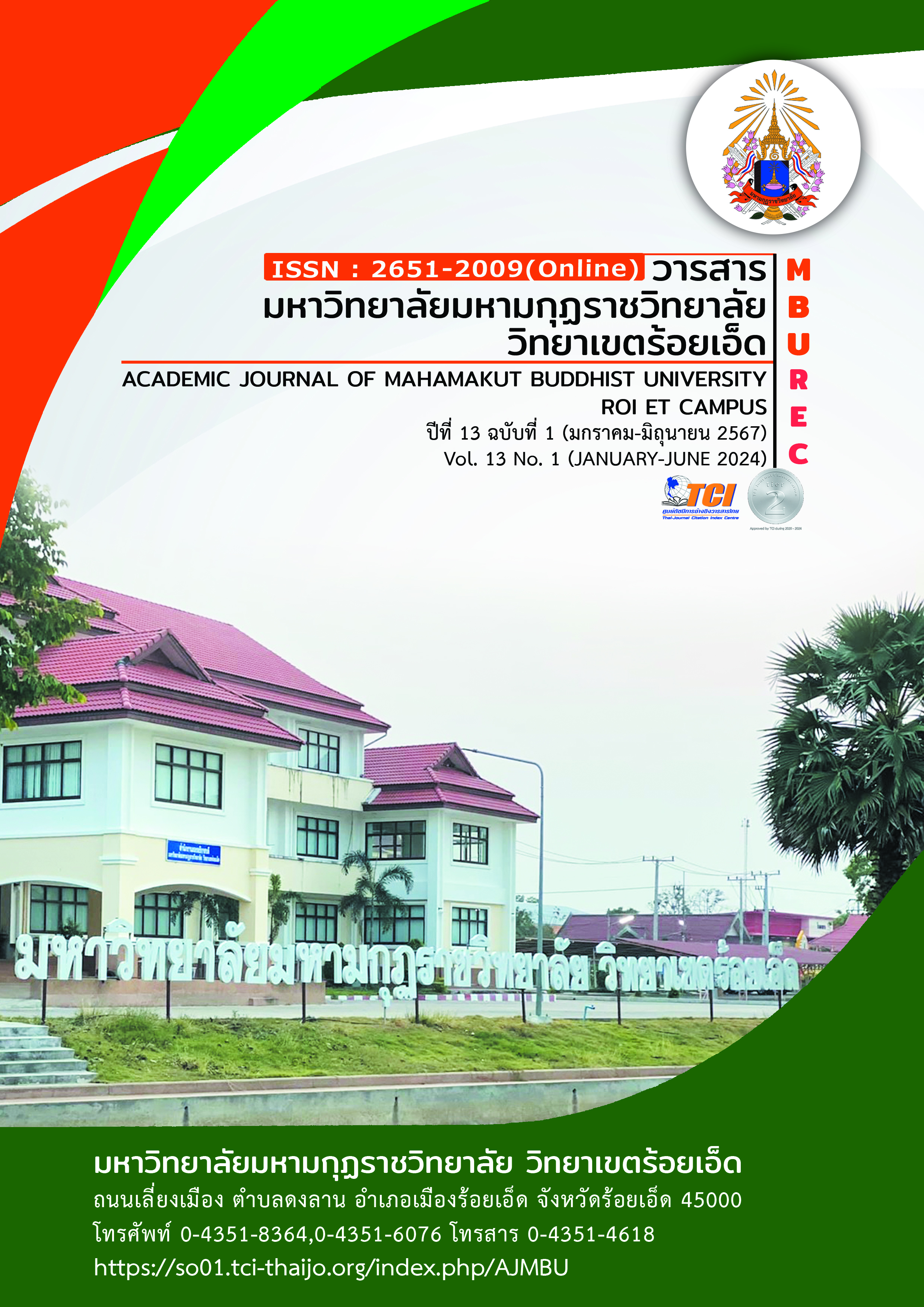THE INTEGRATION OF BUDDHIST PRINCIPLES IN THE DEVELOPEMENT OF PEOPLE’S COMMUNITIES AT HUAIAENG SUB-DISTRICT ADMINISTRATIVE ORGANIZATION AREA, MUENG MAHASARAKHAM DISTRICT, MAHASARAKHAM PROVINCE
Main Article Content
Abstract
The objectives of this article are 1) to study the state of integration of Buddhist principles in people's community development; Huai Ang Subdistrict Administrative Organization area Mueang Maha Sarakham District Maha Sarakham Province 2) to compare ideas See the integration of Buddhist principles in developing the community of people classified by gender, age, education level, and occupation. 3) To study recommendations for integrating Buddhist principles. in the development of people's communities Huai Ang Subdistrict Administrative Organization area 4) To use research results for policy and spatial use. It is a quantitative research method. The sample group used in the research included people aged 18 years and over who had the right to choose. Set according to the announcement of the names of 341 people eligible to vote for Subdistrict Administrative Organization Council members/President of the Subdistrict Administrative Organization 2020 in the Huang Ang Subdistrict area. The research instrument was a questionnaire with content validity between 0.67-1.00 and has a confidence level of 0.95. Statistics used in data analysis include percentage, mean, standard deviation, t-test and F-test (One-way ANOVA) values.
The results showed that: 1. The state of integrating Buddhist Principles in the development of People’s communities at Huai Ang Sub-district Administrative Organization Area, overall, was at a high level. When considering by aspect in order from the highest average to the lowest were: creating a learning society and revitalizing civilization (Sangaha Vatthu Principles) followed by sustainable environment, and the side with the lowest average was creating strong community. 2. The results of comparing opinions on the integration of Buddhist Principles in community development, classified by gender, age, education level, and occupation overall, gender was no difference. Other than that, the difference was statistically significant at the .05 level. 3. Recommendations on Integrating Buddhist Principles in development of people community were: cultivated consciousness training to develop the minds of the people in the community, developed from the inside to the outside sustainable manner. 4. Application of research results in terms of policy and area: Huai Ang Sub-district Administrative Organization should pay more attention to community development, supporting and increasing the budget in every community development project to enhance the efficiency of community development.
Article Details

This work is licensed under a Creative Commons Attribution-NonCommercial-NoDerivatives 4.0 International License.
References
กันตภณ หนูทองแก้ว. (2562). การประยุกต์ใช้หลักสังคหวัตถุในโครงการประชารัฐเพื่อส่งเสริมการ พัฒนาชุมชนศรีธรรมโศก จังหวัดนครศรีธรรมราช. วิทยานิพนธ์รัฐศาสตรมหาบัณฑิต. บัณฑิตวิทยาลัย : มหาวิทยาลัยมหามกุฏราชวิทยาลัย.
ชานนท์ สมอุดร ผู้ให้สัมภาษณ์. 13 กรกฎาคม 2565. ณ ที่ทำการกำนันตำบลห้วยแอ่ง อำเภอเมืองมหาสารคาม จังหวัดมหาสารคาม
ณัฏฐวุฒิ ทรัพย์อุปถัมภ์. (2558). ทฤษฎีและหลักการพัฒนาชุมชน. พิมพ์ครั้งที่ 3. จันทบุรี : มหาวิทยาลัยราชภัฏรำไพพรรณี.
บุญชม ศรีสะอาด. (2553). การวิจัยเบื้องต้น. พิมพ์ครั้งที่ 7. กรุงเทพมหานคร : สุวีริยาสาส์น.
ประภาส ทัตติวงษ์ ผู้ให้สัมภาษณ์. 12 กรกฎาคม 2565. ณ องค์การบริหารส่วนตำบลห้วยแอ่ง อำเภอเมืองมหาสารคาม จังหวัดมหาสารคาม
ปาริชาติ วลัยเสถียร. (2546). ประวัติความเป็นมาของการพัฒนาชุมชน เอกสารประกอบการสอนวิชา พช. 611 ทฤษฎีและกระบวนการพัฒนาชุมชน. กรุงเทพมหานคร : คณะสังคมสงเคราะห์ศาสตร์ มหาวิทยาลัยธรรมศาสตร์.
พระณเดช ปคุโณ (สมบูรณ์พร้อม). (2564). แนวทางการพัฒนาชุมชนตามหลักสังคหวัตถุ 4 ของ ประชาชนชุมชน OTOP บ้านบกหวาน ตำบลค่ายบกหวาน อำเภอเมืองหนองคาย. วิทยานิพนธ์พุทธศาสตรมหาบัณฑิต สาขารัฐประศาสนศาสตร์. บัณฑิตวิทยาลัย : มหาวิทยาลัยมหาจุฬาลงกรณราชวิทยาลัย.
พระพรหมคุณาภรณ์ (ป.อ.ปยุตฺโต). (2546). พจนานุกรมพุทธศาสตร์ ฉบับประมวลธรรม. กรุงเทพมหานคร : โรงพิมพ์มหาจุฬาลงกรณราชวิทยาลัย.
พระวิศรุต ฐิตโสภโณ (อนุวงษา). (2561). การประยุกต์ใช้หลักสังคหวัตถุ 4 ในการพัฒนาชุมชนของ พระสังฆาธิการ ในเขตอำเภอเมือง จังหวัดเชียงราย. วิทยานิพนธ์รัฐศาสตรมหาบัณฑิต สาขาวิชาการปกครอง. บัณฑิตวิทยาลัย : มหาวิทยาลัยมหามกุฏราชวิทยาลัย.
มหาจุฬาลกรณราชวิทยาลัย. (2525). พระไตรปิฎกภาษาไทยฉบับหลวง. กรุงเทพมหานคร : กรมการศาสนา.
องค์การบริหารส่วนตำบลห้วยแอ่ง. (2564). แผนการพัฒนาท้องถิ่น พ.ศ. 2566-2570. สืบค้นเมื่อ 16 กรกฎาคม 2565. จาก https://huay-ang. go.th/select_news.php?news_id=608


